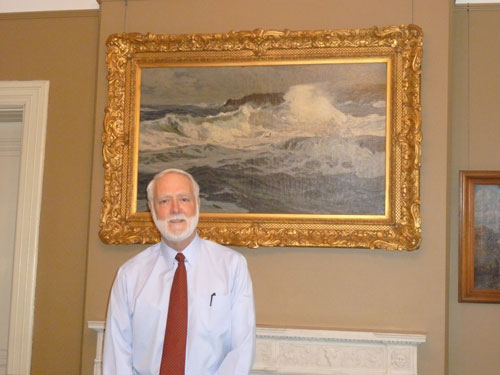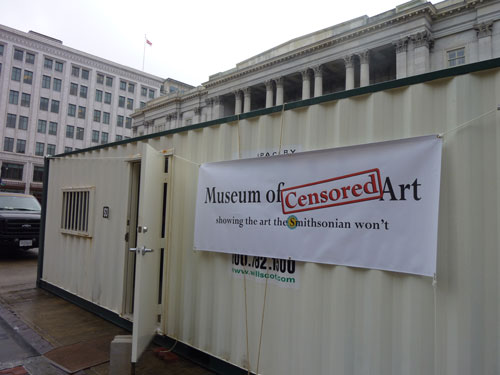
Smithsonian Secretary G. Wayne Clough in his office with Frederick Waugh's "Southwesterly Gale, St. Ives," 1907, Smithsonian American Art Museum
How did Smithsonian Secretary G. Wayne Clough analyze the potential damage from the political, cultural and religious firestorm that erupted over his order to remove one work from the National Portrait Gallery's provocative, gay-themed "Hide/Seek" exhibition?
In a wide-ranging, 40-minute interview at his Washington office on Tuesday, the Smithsonian's head (formerly president of the Georgia Institute of Technology) told me that in working through the problems posed by the controversy, he had called upon the reasoning skills he had honed as an engineer:
People should understand that this was a unique situation: It was an exhibit that no other museum that had been approached was willing to do. We took it on because we thought it was an important topic. It was mounted and came up at the time of a very contentious election cycle. So that's where my engineering background comes in: I can do the math here. The possibility of this ever happening again is extremely remote.
That's not scientific thinking; it's wishful thinking. No statistical formula can solve the complex conundrums engendered by the controversy over David Wojnarowicz's hot-button video, "A Fire in My Belly" and by the Smithsonian's ham-fisted handling of it. Those of us who look at this contretemps from the perspective of the art world, rather than the engineering world, know too well that once the Culture Wars have gained momentum, it's not so easy to achieve a ceasefire.

Protest shed that offers continuous showings of David Wojnarovicz's "A Fire in My Belly," parked directly in front of the National Portrait Gallery
In my CultureGrrl blog, I have sympathized with Clough's decision to sacrifice the video in order to save the show, which some Congressional art critics have said should be shut down. His rapid response, as he explains below, was an attempt to nip the crisis in the bud. But cultural figures and gay activists have now targeted the "censorship" as a cause célèbre, organizing a protest demonstration today in Los Angeles, where Clough is to make his first comments about the controversy in a public forum, almost two months after the fact. His Los Angeles oration on New Perspectives at the Smithsonian was planned before the Smithsonian's "perspective" became almost as roiled as the sea in the painting that adorns Clough's office.
The Smithsonian's leader should have gotten out in front of this issue from the get-go, explaining and defending his actions publicly, not merely behind-the-scenes. His only acknowledged mea culpas were that he should have had "a better listening cycle... before the fact" and he should have sought counsel from his art museum directors, as soon as things got contentious, for guidance on "who to reach out to quickly." He said that the mission of the Smithsonian's existing Directors Advisory Group, formed to help with "the difficult days we've got ahead with the budget," will now be expanded to include "addressing issues where we have controversy."
In a case of too-little-too-late, Clough on Tuesday finally opened himself to media queries, in consecutive one-on-ones with me and two other reporters.
As he told the others, Clough unequivocally declared to me:
"I don't regret the decision [to remove the video]. I think it was the right decision for the exhibit, as well as for the long-term strength of this institution."
Then he went further:
I think it was very important to cut off the dialogue that was headed towards, in essence, hijacking the exhibit away from us and putting it into the context of religious desecration. This continues to be a powerful exhibit about the contributions of gay and lesbian artists. It was not about religious iconography and it was not about desecration. When you look at the news cycles that take over, their [the show's critics'] megaphones are this big [making a broad gesture] and our megaphone is this big [a small gesture]. We don't control that. And when it gets out of control, you can't get it back.
What's more, Clough asserted that the video should never have been included in the show in the first place: "We didn't see that particular work through the lens of how someone else would perceive it -- as religious desecration. We could have done a better job there. And we will learn from that."
Pointing out that many people disagree with the interpretation of Wojnarowicz's video as religious desecration, I asked how and where the Smithsonian will draw the lines between appropriate and inappropriate objects for display -- a highly subjective judgment.
Making these distinctions, he replied, is "really a curatorial/director decision." My obvious response was that the National Portrait Gallery's director and curators had indeed made a decision -- one that Clough overruled. Would curators and directors now have to flag every object in every show that might cause a kerfuffle, seeking approval from the Smithsonian's top brass?
That's when I learned about the Smithsonian's version of Catch-22, known on the Mall as Smithsonian Directive 603. This 2003 internal document, written in impeccable bureaucrat-ese, decrees:
Museums and exhibiting units, in concert with the Under Secretary, must establish mechanisms to identify potentially sensitive issues. Museums and exhibiting units should address these issues by carefully reviewing the topic and approach to determine whether changes in direction or in degree of emphasis or balance are appropriate, even if the viewpoints are based on solid scientific evidence or scholarly interpretation [emphasis added]....
When sensitive issues arise, the exhibiting unit will notify the responsible unit Director. The Director will bring the matter to the attention of the Under Secretary, who will monitor the issue and consult with the Office of Government Relations and the Director of Communications or other senior staff, as necessary, to ensure the Smithsonian is prepared to deal with public debate or questions from the public, news media, Congress and the Administration.
I warily inquired whether there are any upcoming shows that have triggered Directive 603. In fact, he said, there is one: In March 2012, the Smithsonian American Art Museum (SAAM) plans to open The Art of Video Games, described as "the first major exhibition to examine comprehensively the evolution of video games as an artistic medium."
"There's a lot of violence in some of those games. We have to be concerned about how we exhibit that," Clough told me. "Obviously, there's a limit to how much violence you want to show when you have a broad audience."
Luckily, just in the nick of time, there's a show coming up this summer at the National Portrait Gallery (which occupies the same building as SAAM) that might mollify some conservative critics -- "One Life: Ronald Reagan," commemorating the centennial year of a president "of great consequence" (as described in the show's announcement).
Maybe the Smithsonian can yet manage to become all things to all people.